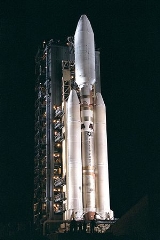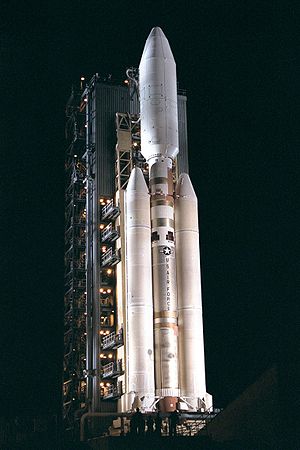
Cape Canaveral Air Force Station Launch Complex 40
Encyclopedia
Cape Canaveral Air Force Station Space Launch Complex 40 (SLC-40), previously Launch Complex 40 (LC-40) is a launch pad
at the north end of Cape Canaveral
, Florida
. It was used by the United States Air Force
for Titan III
and Titan IV
launches between 1965 and 2005.
On April 25, 2007, the US Air Force leased the complex to SpaceX
to launch the Falcon 9
rocket.
 The first launch from LC-40 was the maiden flight of the Titan IIIC (June 18, 1965), carrying two transtage
The first launch from LC-40 was the maiden flight of the Titan IIIC (June 18, 1965), carrying two transtage
upper stages to test the functionality of the vehicle.
Two interplanetary missions were launched from the pad:
The final Titan launch from SLC-40 was the Lacrosse-5
reconnaissance satellite (Titan IV-B, April 30, 2005).
The tower was disassembled during late 2007 and early 2008. Demolition of the Mobile Service Structure (MSS), by means of a controlled explosion, occurred on April 27, 2008, by Controlled Demolition, Inc.
Falcon 9
rocket. Renovations include installation of new liquid oxygen
and kerosene
tanks and construction of a hangar for rocket and payload preparation.
The first Falcon 9 rocket arrived at SLC-40 in late 2008, and was erected for the first time on January 10, 2009. It successfully reached orbit on its maiden launch on June 4, 2010.
SLC-40 will become the launch facility of the SpaceX Dragon, a reusable automated cargo vehicle which will replace the cargo capabilities of the Space Shuttle
following its retirement in 2011. SpaceX successfully launched the first test flight for the Dragon from SLC-40 on December 8, 2010.
. The commercial crew enabling work would include a "base task" of refurbishing and reactivating SLC-40 power transfer switches, performing maintenance on the lower Aerospace Ground Equipment (AGE) substation and motor control centers, installing bollards around piping, replacing the door frame and threshold for the Falcon Support Building mechanical room and repairing fencing around the complex perimeter. Several optional tasks would include work installing conductive flooring in the Hangar Hypergol area, performing corrosion control inspection and maintenance of the lightning protection tower's structural steel, upgrading and refurbishing other facility equipment and performing corrosion control on rail cars and pad lighting poles, painting several buildings, repairing and improving roads, and hydro-seeding the complex.
Launch pad
A launch pad is the area and facilities where rockets or spacecraft lift off. A spaceport can contain one or many launch pads. A typical launch pad consists of the service and umbilical structures. The service structure provides an access platform to inspect the launch vehicle prior to launch....
at the north end of Cape Canaveral
Cape Canaveral Air Force Station
Cape Canaveral Air Force Station is an installation of the United States Air Force Space Command's 45th Space Wing, headquartered at nearby Patrick Air Force Base. Located on Cape Canaveral in the state of Florida, CCAFS is the primary launch head of America's Eastern Range with four launch pads...
, Florida
Florida
Florida is a state in the southeastern United States, located on the nation's Atlantic and Gulf coasts. It is bordered to the west by the Gulf of Mexico, to the north by Alabama and Georgia and to the east by the Atlantic Ocean. With a population of 18,801,310 as measured by the 2010 census, it...
. It was used by the United States Air Force
United States Air Force
The United States Air Force is the aerial warfare service branch of the United States Armed Forces and one of the American uniformed services. Initially part of the United States Army, the USAF was formed as a separate branch of the military on September 18, 1947 under the National Security Act of...
for Titan III
Titan III
The Titan IIIC was a space booster used by the United States Air Force. It was launched from Cape Canaveral Air Force Station, FL., and Vandenberg Air Force Base, CA. It was planned to be used as a launch vehicle in the cancelled Dyna-Soar and Manned Orbiting Laboratory programs...
and Titan IV
Titan IV
The Titan IV family of space boosters were used by the U.S. Air Force. They were launched from Cape Canaveral Air Force Station, Florida, and Vandenberg Air Force Base, California. At the time of its introduction, the Titan IV was the "largest unmanned space booster used by the Air Force."The...
launches between 1965 and 2005.
On April 25, 2007, the US Air Force leased the complex to SpaceX
SpaceX
Space Exploration Technologies Corporation, or more popularly and informally known as SpaceX, is an American space transport company that operates out of Hawthorne, California...
to launch the Falcon 9
Falcon 9
Falcon 9 is a rocket-powered spaceflight launch system designed and manufactured by SpaceX. Both stages of its two-stage-to-orbit vehicle use liquid oxygen and rocket-grade kerosene propellants...
rocket.
Titan

Transtage
Transtage was an American upper stage used on Titan III rockets. 40 were launched, of which three failed.The first launch, boosted by a Titan IIIA carrier rocket, occurred on 1 September 1964. The Transtage failed to pressurise, resulting in premature engine cutoff, and a failure to reach orbit....
upper stages to test the functionality of the vehicle.
Two interplanetary missions were launched from the pad:
- The failed Mars ObserverMars ObserverThe Mars Observer spacecraft, also known as the Mars Geoscience/Climatology Orbiter, was a 1,018-kilogram robotic space probe launched by NASA on September 25, 1992 to study the Martian surface, atmosphere, climate and magnetic field...
spacecraft (September 25, 1992) - The Cassini–Huygens mission to SaturnSaturnSaturn is the sixth planet from the Sun and the second largest planet in the Solar System, after Jupiter. Saturn is named after the Roman god Saturn, equated to the Greek Cronus , the Babylonian Ninurta and the Hindu Shani. Saturn's astronomical symbol represents the Roman god's sickle.Saturn,...
(October 15, 1997)
The final Titan launch from SLC-40 was the Lacrosse-5
Lacrosse (satellite)
For the 2009 Lunar Impactor Mission designed to crash into the moon, see LCROSS.Lacrosse and Onyx are the code names for the United States' National Reconnaissance Office terrestrial radar imaging reconnaissance satellite. While not officially confirmed by the NRO or anybody in the U.S...
reconnaissance satellite (Titan IV-B, April 30, 2005).
The tower was disassembled during late 2007 and early 2008. Demolition of the Mobile Service Structure (MSS), by means of a controlled explosion, occurred on April 27, 2008, by Controlled Demolition, Inc.
Falcon
During April 2008, construction started on the ground facilities necessary to support the launch of the SpaceXSpaceX
Space Exploration Technologies Corporation, or more popularly and informally known as SpaceX, is an American space transport company that operates out of Hawthorne, California...
Falcon 9
Falcon 9
Falcon 9 is a rocket-powered spaceflight launch system designed and manufactured by SpaceX. Both stages of its two-stage-to-orbit vehicle use liquid oxygen and rocket-grade kerosene propellants...
rocket. Renovations include installation of new liquid oxygen
Liquid oxygen
Liquid oxygen — abbreviated LOx, LOX or Lox in the aerospace, submarine and gas industries — is one of the physical forms of elemental oxygen.-Physical properties:...
and kerosene
Kerosene
Kerosene, sometimes spelled kerosine in scientific and industrial usage, also known as paraffin or paraffin oil in the United Kingdom, Hong Kong, Ireland and South Africa, is a combustible hydrocarbon liquid. The name is derived from Greek keros...
tanks and construction of a hangar for rocket and payload preparation.
The first Falcon 9 rocket arrived at SLC-40 in late 2008, and was erected for the first time on January 10, 2009. It successfully reached orbit on its maiden launch on June 4, 2010.
SLC-40 will become the launch facility of the SpaceX Dragon, a reusable automated cargo vehicle which will replace the cargo capabilities of the Space Shuttle
Space Shuttle
The Space Shuttle was a manned orbital rocket and spacecraft system operated by NASA on 135 missions from 1981 to 2011. The system combined rocket launch, orbital spacecraft, and re-entry spaceplane with modular add-ons...
following its retirement in 2011. SpaceX successfully launched the first test flight for the Dragon from SLC-40 on December 8, 2010.
Commercial crew upgrades
In October 2009, NASA provided a pre-solicitation notice regarding an effort to be funded under the American Recovery and Reinvestment Act of 2009American Recovery and Reinvestment Act of 2009
The American Recovery and Reinvestment Act of 2009, abbreviated ARRA and commonly referred to as the Stimulus or The Recovery Act, is an economic stimulus package enacted by the 111th United States Congress in February 2009 and signed into law on February 17, 2009, by President Barack Obama.To...
. The commercial crew enabling work would include a "base task" of refurbishing and reactivating SLC-40 power transfer switches, performing maintenance on the lower Aerospace Ground Equipment (AGE) substation and motor control centers, installing bollards around piping, replacing the door frame and threshold for the Falcon Support Building mechanical room and repairing fencing around the complex perimeter. Several optional tasks would include work installing conductive flooring in the Hangar Hypergol area, performing corrosion control inspection and maintenance of the lightning protection tower's structural steel, upgrading and refurbishing other facility equipment and performing corrosion control on rail cars and pad lighting poles, painting several buildings, repairing and improving roads, and hydro-seeding the complex.

